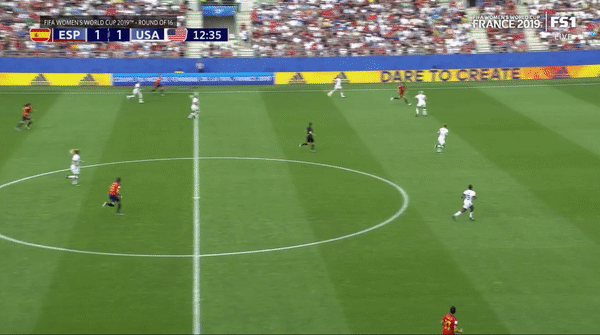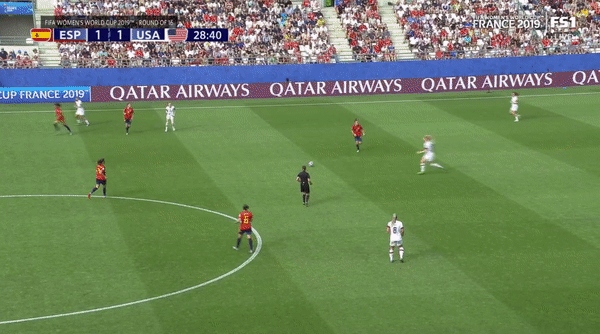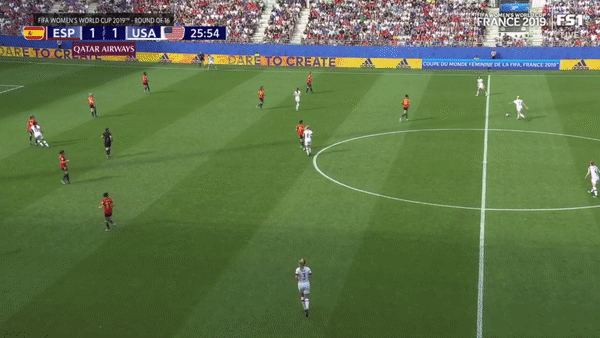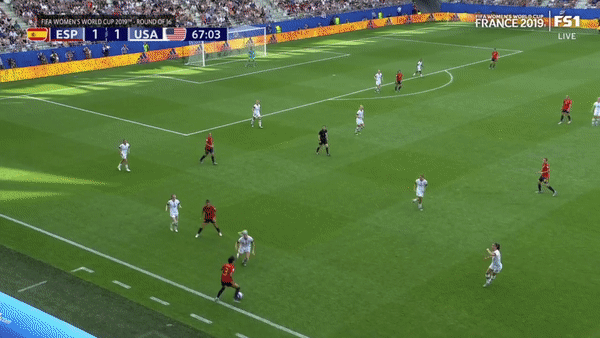Jill Ellis benched an MVP. But that wasn't why USWNT struggled with Spain
The narrative began to crystalize before a ball had even been kicked. On a muggy evening in northern France, Jill Ellis made a bold call. Back across the Atlantic, an army of doubters assembled. They knew little about the what of their impending criticism, but everything about the who. No matter the intricacies of the performance. No matter the result.
Such is the life of a soccer coach, consistently one of the most convenient culprits in all of sports. And to say Ellis is no different would be grossly euphemistic. Fans – and Hope Solo – believe the U.S. women’s national team wins despite her. Players have expressed concern about her. Media heap pressure onto her. Never mind that she won a World Cup and has the USWNT favored to win a second.
So when Ellis benched Lindsey Horan on Monday for a round of 16 rumble with Spain, pitchforks were readied. Three hours later, only a controversial second-half penalty kept them at bay. The U.S. won – survived and advanced. But nobody seems particularly satisfied.
The bulk of the ire, naturally, has been aimed at Ellis. It took the shape of furious tweets and provocative headlines. Many blamed the coach responsible for putting dominant players in a position to be dominant.
Few, of course, blamed players for failing to be dominant.

But any U.S. shortcomings on Monday – if you can even call them that – had little to do with Ellis. They had more to do with those players you know and love. The ones Ellis wouldn’t dare drop. The ones whose brilliance her entire USWNT system depends on. They were the reason the Americans limped rather than cruised into the World Cup quarters.
Benching Horan was questionable ... until it worked
On the surface, benching Horan was absolutely grounds for fair criticism. The 25-year-old won the NWSL’s 2018 MVP award with a season unlike any the league had seen before. She is considered by many the USWNT’s best player, and a top-three midfielder in the world. Her vast skill set – from the goal-scoring to the duel-winning to the chance-creating – seemingly made her undroppable. Statistically, she’s actually a better tackler than tackling-extraordinaire Julie Ertz and a better progressive passer than playmaker Rose Lavelle.
Ellis, though, went with a midfield three of Lavelle, Ertz and Sam Mewis – and later said the decision was unrelated to Horan sitting on a yellow card. With the game tied at halftime, of course, social media was ablaze. The uproar was best summarized by some shade from Horan’s club coach in Portland, Mark Parsons:
— Mark Parsons (@mparsons_1) June 24, 2019
The midfield, however, was anything but the problem. Lavelle, Ertz and Mewis were arguably the three best players on the pitch. Excluding goal-scorers, they were the three highest-rated.
They bossed the game as a unit, but more so individually, each in her own way. Lavelle galloped past Spanish adversaries, carrying the ball without breaking stride. She created the game’s best chance with a deadly through-ball to Megan Rapinoe. The USWNT machine – which, by the way, Ellis constructed – was humming early on.

Mewis, meanwhile, was once again superb from box to box. She sprayed passes to wingers and overlapping fullbacks. She quashed danger at the edge of her own penalty area. She broke up Spanish attacks and launched American ones.

She had 13 ball recoveries – joint-most of the 28 players who saw the field.
If anybody is the like-for-like replacement for Horan – the one keeping the MVP on the bench – it’s Mewis. And she absolutely justified Ellis’ decision.
And Ertz ... well, she was Ertz. One-of-a-kind. She’s not a line-breaking passer, but doesn’t have to be when she can simply distribute to Lavelle and Mewis. She was mistake-free and positionally sound – and a core reason the U.S. defense was mostly impermeable.
The leaks were individual errors. The foundation – again, an Ellis construction – was very solid. Only Becky Sauerbrunn’s gaffe and Kelley O’Hara’s overaggression leant Spain opportunities. La Roja’s final tally was between 0.2 and 0.4 Expected Goals, depending on the model. Defending wasn’t the problem.
Nor was the controversially-selected midfield.
Forwards were.
The front three’s no good, very bad day
Megan Rapinoe is one of the most inventive wingers in the world. Tobin Heath is one of the most daring and devastating. Alex Morgan is the most complete striker the U.S. has had in some time.
They are all must-starts. All close to the top of any list titled “Why the U.S. is the 2019 Women’s World Cup favorite.” All brilliant.
And the U.S. managed zero shots on goal from open play against Spain because those three weren’t brilliant on Monday.
Rapinoe, for her part, admitted as much after the match. By the end of it, she was in Spanish right back Marta Corredera’s pocket. Time and time again, Lavelle and Mewis fed Rapinoe the ball in space. Time and time again, she was repelled and dispossessed.
The 33-year-old icon, for the first time, looked like age was catching up with her. She lacked burst. Her first step was slow, her top-end speed ordinary. Her decision-making, at times, was also curious, and her lack of final-third urgency frustrating.
Spot-kick conversions aside, a mid-first-half sequence encapsulated her day:

Heath, on the other hand, was downright invisible after winning the early penalty. She lost nine of her 12 duels, completed only one dribble, and was dispossessed four times. Clever off-ball movement was nonexistent. Her silky touch completely deserted her.

And Morgan? She sure looked injured. Ellis said Sunday that the 29-year-old striker was “fine.” But she was chopped to the ground in the opening minute, and floored again inside three minutes. She was the most-fouled player on the pitch.
In between the hacks, her movement wasn’t sharp. She completed only half of her passes. On a few occasions, pain – or something unusual – almost seemed to impede her natural soccer instincts.

And this is where the one fair criticism of Ellis comes into play: Leaving all three attackers on the field for 84-plus minutes was inexcusable.
Yes, Ellis should have made subs earlier
Professional soccer coaches, as a breed, wait too long to make subs. Ellis’ negligence on Monday, however, was particularly egregious.
Forget Horan for a sec. The USWNT boss had Carli Lloyd, Christen Press and Mallory Pugh at her disposal – three borderline world-class attackers. She had a first-choice forward line that was struggling. And she used the bench mob ... for all of five combined (non-stoppage-time) minutes.
Ellis was well within her right to stay the course at halftime. Her machine was humming, even if clear-cut chances weren’t flowing. Around the hour mark, though, the U.S. began to run out of ideas. That Ellis made it past the 65th minute without a single sub was mismanagement. That she made it to the 85th minute was malpractice.
Then again, it is impossible – or, rather, unfair – to fault her starting lineup. And if the the front three had played to their lofty standards, none of this would be a discussion. The game would have been won by multiple goals. The bold call to drop Horan might have been hailed as ingenious.
That they didn’t isn’t Ellis’ fault. Rather, it’s why none of this is Ellis’ fault. Any U.S. gameplan is fueled by an expectation that Rapinoe, Heath and Morgan will be excellent. Because they have been more often than not, and very likely will be in the near future.
So Monday was no cause for worry. Perhaps slight concern about Morgan’s health. But certainly not about the head coach.
– – – – – – –
Henry Bushnell is a features writer for Yahoo Sports. Have a tip? Question? Comment? Email him at henrydbushnell@gmail.com, or follow him on Twitter @HenryBushnell, and on Facebook.
More from Yahoo Sports:

